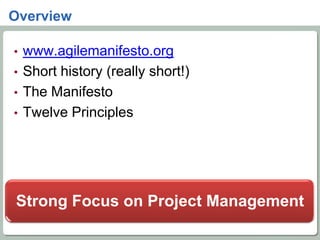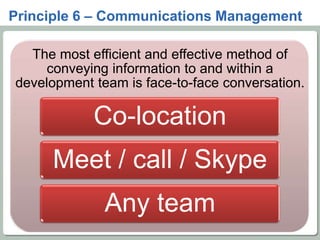PM Podcast 186 - Agile Manifesto for Project Managers
- 1. www.pm-podcast.com Episode 186 The Agile Manifesto For Project Managers Presented by: Cornelius Fichtner, PMP
- 2. www.pm-podcast.com This presentation is available as a PM Podcast video episode at www.pm-podcast.com
- 3. Overview • www.agilemanifesto.org • Short history (really short!) • The Manifesto • Twelve Principles Strong Focus on Project Management
- 4. History of The Agile Manifesto • 17 proponents of various SW development methods met to discuss better ways to develop software • Known as the “Agile Alliance” • The Agile Manifesto was released on February 13, 2001. • Contains core values & principles • More history: • http://agilemanifesto.org/history.html
- 5. The Agile Manifesto We are uncovering better ways of developing software by doing it and helping others do it. Through this work we have come to value: Individuals and interactions over processes and tools Working software over comprehensive documentation Customer collaboration over contract negotiation Responding to change over following a plan That is, while there is value in the items on the right, we value the items on the left more.
- 6. Interpretation for Project Managers Individuals and interactions over processes and tools • Let team & users cooperate • Become a facilitator Working software over comprehensive documentation • Focus on delivery • Don’t abandon documentation
- 7. Interpretation for Project Managers Customer collaboration over contract negotiation • Customer vision is at center • Manage relationships not contracts Responding to change over following a plan • Let customers change their mind • Use change-friendly methodologies
- 8. “This would NEVER work in our company!” Individuals and interactions over • Prescribed methodology processes and tools Working software over comprehensive • PMP Exam Simulator documentation Customer collaboration over • Legal requirements contract negotiation Responding to change over • Construction Projects following a plan
- 9. “Solution” Do what you can •Remember: There is value in the things on the right
- 10. 12 Manifesto Principles Software Changes Delivery Coop Motivation Communication Progress Sustainability Excellence Simplicity Self-organization Reflect
- 11. Principle 1 – Results orientated Our highest priority is to satisfy the customer through early and continuous delivery of valuable software. Satisfied customers = #1 Deliver, deliver, deliver Focus on your customer
- 12. Principle 2 – Change Management Welcome changing requirements, even late in development. Agile processes harness change for the customer's competitive advantage. Changes are good! We welcome changes to help you Focus on features, not budget
- 13. Principle 3 – Frequent Milestones Deliver working software frequently, from a couple of weeks to a couple of months, with a preference to the shorter timescale. Faster time to market Short sprints, iterations, cycles… Release on time
- 14. Principle 4 – Teamwork Business people and developers must work together daily throughout the project. Single point of contact? Developers & customers Team Developoment
- 15. Principle 5 – Yes they can! Build projects around motivated individuals. Give them the environment and support they need, and trust them to get the job done. PM’s job in Agile Embrace Theory Y Step back
- 16. Principle 6 – Communications Management The most efficient and effective method of conveying information to and within a development team is face-to-face conversation. Co-location Meet / call / Skype Any team
- 17. Principle 7 – Progress Measurement Working software is the primary measure of progress. “We are on target” Documents don’t count Internal reporting?
- 18. Principle 8 – Maintenance Agile processes promote sustainable development. The sponsors, developers, and users should be able to maintain a constant pace indefinitely. Post project Backlog, burn-down, etc. Prioritization & collaboration
- 19. Principle 8 – Quality Continuous attention to technical excellence and good design enhances agility. Supports #1 and #3 Good design needed PM becomes conscience
- 20. Principle 10 – Just DON’T do it! Simplicity--the art of maximizing the amount of work not done--is essential. Agile ≠ Less Simplify = Central Tradeoff
- 21. Principle 11 – Team organization The best architectures, requirements, and designs emerge from self-organizing teams. Intelligent people! Let them organize Facilitate
- 22. Principle 12 – Lessons Learned At regular intervals, the team reflects on how to become more effective, then tunes and adjusts its behavior accordingly. Throughout project Not only at end Agility = changeability
- 23. Agile Manifesto - Review There is room for PMs Our role changes PM’s responsibility is distributed FACILITATOR Different title
- 24. Thank you for watching!
- 25. Thank you for watching! www.pm-podcast.com info@pm-podcast.com
- 26. And finally, we have this… The difference between project success and failure is a good PR company
- 27. www.pm-podcast.com Until Next Time!



























